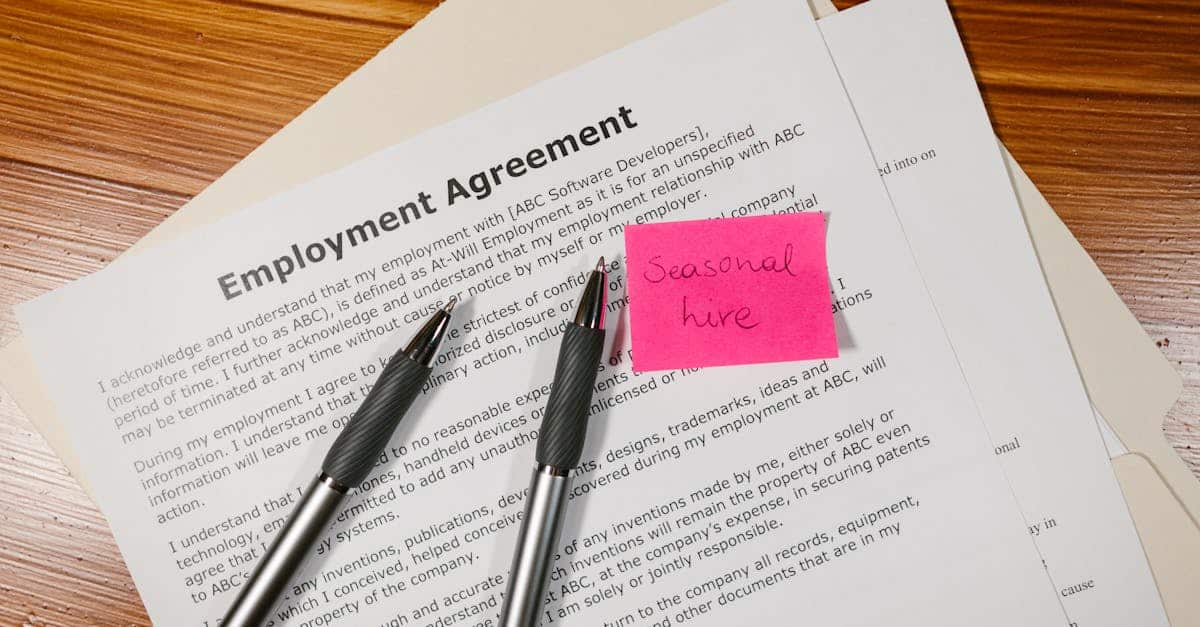
Introduction
Every interview and take‑home assessment is a crossroads: you either protect your product’s trade secrets or risk a costly leak—while slow, manual paperwork leaves candidates waiting and hires going elsewhere. Tight, targeted NDAs and consistent offer letters aren’t just legal safeguards; when paired with document automation they become hiring levers that reduce IP risk and compress time‑to‑hire.
What this post covers: a practical playbook for a two‑tier NDA approach, auto‑generated offer letters that merge NDA status with compensation and role clauses, e‑sign workflows that create auditable handoffs into employee agreements and onboarding, clear templates for revising or rescinding offers, and the KPIs to measure and improve both protection and speed.
Why candidate NDAs matter: protecting trade secrets during interviews and take‑home assessments
Protecting confidential information early matters. Candidates may see product designs, source snippets, customer lists, or sensitive business strategies during interviews or take‑home assessments. A short, targeted non‑disclosure agreement (NDA) creates a legal basis to deter misuse and gives the company rights to seek remedies if a leak occurs.
What to cover in candidate NDAs
Keep candidate NDAs focused and enforceable: define confidential information narrowly, set a reasonable time limit, and exclude information already publicly known or independently developed by the candidate. This reduces the risk the NDA will be considered overly broad in court and increases compliance.
- Why it ties into employee agreements: Candidate NDAs often roll into the broader employment agreement or employment contract after hire, preserving continuity of obligations.
- Practical tip: Use the company NDA template to streamline screening — see a ready form at https://formtify.app/set/non-disclosure-agreementemployee-b9s6h.
Compliance and candidate experience: Balance legal protection with candidate trust. Make NDAs short, explain why they’re needed, and avoid excessive restrictions that could scare off top talent.
Designing a two‑tier NDA approach: pre‑screening vs. role‑specific confidentiality terms
Two tiers reduce friction while increasing protection. Use a light pre‑screening NDA for early interviews and assessments, and a fuller, role‑specific confidentiality clause in the employment agreement (or contractor agreement) for candidates who progress.
Tier 1 — Pre‑screening NDA
Short, one‑page agreement that covers intake materials and assessment tasks. Aim for clarity and speed so candidates can review and sign quickly before take‑home assignments.
Tier 2 — Role‑specific confidentiality
Embed comprehensive confidentiality, IP assignment, and any necessary export controls into the employment agreement or independent contractor agreement. This is where you specify sensitive project exclusions, non‑disclosure durations, and remedies.
- Integration: Make the second tier part of the formal employment contract or employment agreement signed at hire — see a sample at https://formtify.app/set/employment-agreement-mdok9.
- Special cases: For contractors, use an independent contractor agreement with tailored confidentiality and deliverable clauses.
Drafting note: Align both tiers with local employment law (e.g., restrictions on non‑competes) to avoid unenforceable terms.
Auto‑generate offer letters that merge NDA status, compensation data and role clauses
Automate consistency and reduce manual errors. When an applicant passes screening, auto‑generate an offer letter that pulls the candidate’s NDA status (signed/unsigned), compensation package, role description, and relevant clauses from your templates.
Key fields to merge
- NDA status: Note whether the pre‑screen NDA is on file and whether additional confidentiality terms will apply post‑hire.
- Compensation & benefits: Base pay, bonus structure, equity, and benefits should be filled programmatically to avoid discrepancies with approval records.
- Role clauses: Job duties, reporting structure, probation period, and termination rights.
Use a canonical offer letter template to produce consistent employment contract language. If you need a starting offer letter template, review: https://formtify.app/set/job-offer-letter-74g61.
Practical checklist: Validate that the offer references the employment agreement or attached confidentiality addendum, and include next steps for signing and e‑onboarding.
E‑sign and orchestration: move candidates from NDA to offer to onboarding with signed audit trails
E‑signatures and workflow orchestration are table stakes. They provide a clear, time‑stamped audit trail from the candidate NDA through the offer and into onboarding documents such as the employment agreement or contractor agreement.
What a clean orchestration looks like
- Candidate signs a pre‑screen non‑disclosure agreement (NDA) electronically.
- System records signature + IP address + timestamp and flags NDA status in the candidate record.
- Offer letter is autogenerated and routed for e‑signature; when accepted, the employment agreement is presented for signature during onboarding.
Audit & retention: Store signed documents securely and map them to employee records. Keep change logs and revocation history for any revised agreements or rescinded offers.
HR and legal benefits: Faster compliance, quicker hiring cycles, and reduced risk of misplaced paper. Ensure your e‑sign provider complies with local electronic signature laws and data protection rules.
Templates and workflows for rescinding, revising or reissuing offers when terms change
Prepare clear, legal workflows for offer changes. Offers can be rescinded or revised for many reasons: budget changes, role reprioritization, failed background checks, or shifting business needs. A documented workflow reduces legal risk and candidate confusion.
Template elements to include
- Rescission notice: Clear language explaining the reason, effective date, and any statutory or contractual obligations (e.g., payout if promised in an agreement).
- Revision letter: Show old vs. new terms, acceptance mechanics, and a deadline for acceptance.
- Reissue workflow: Approval gates, updated compensation approvals, and reissued offer‑to‑sign pipelines that maintain previous NDA and background check status.
Practical steps:
- Audit the signed NDA and employment agreement to see whether rescission triggers any obligations.
- Communicate quickly and in writing. Use templated language consistent with your employment contract and local law.
- Keep an audit trail of revisions and maintain candidate records for dispute defense.
For reusable employment‑grade templates, reference your core employment agreement and offer letter templates: https://formtify.app/set/employment-agreement-mdok9 and https://formtify.app/set/job-offer-letter-74g61.
Key KPIs: time‑to‑sign, NDA acceptance rate, and leak incidents reduction
Track the right KPIs to manage risk and speed. Focus on metrics that connect candidate experience to protection of IP and hiring velocity.
Primary KPIs
- Time‑to‑sign: Median elapsed time from sending NDA or offer to signed completion. Shorter times indicate clearer docs and streamlined flows.
- NDA acceptance rate: Percentage of candidates who sign the pre‑screen NDA. A low rate may signal overly broad terms or confusing language.
- Leak incidents reduction: Number of suspected or confirmed confidentiality breaches tied to pre‑hire assessments per hiring cycle.
Secondary KPIs
- Offer acceptance rate, time‑to‑hire, and number of reissued offers.
- Compliance rate for required clauses in the employment agreement (IP assignment, confidentiality, termination).
Targets and actions: Set realistic baselines (e.g., time‑to‑sign under 48 hours for NDAs), then iterate: shorten language, streamline e‑sign steps, and improve candidate communication to raise NDA acceptance and reduce leak incidents.
Summary
Practical wrap‑up: A two‑tier NDA strategy, combined with autogenerated offer letters and e‑sign orchestration, gives teams an efficient way to protect sensitive IP while keeping candidates moving through the funnel. Short, narrowly drafted candidate NDAs reduce legal friction; role‑specific confidentiality and IP assignment belong in the employment agreement at hire. Automated merging of NDA status, compensation data and role clauses cuts manual error, speeds time‑to‑hire, and creates auditable trails that HR and legal can rely on. To start applying these practices and access templates and workflow tools, visit https://formtify.app.
FAQs
What is an employee agreement?
An employee agreement is a contract that defines the working relationship: duties, compensation, benefits, hours, and termination terms. It often includes legal protections such as confidentiality, IP assignment, and post‑hire obligations to protect company assets. Having clear, written terms helps both parties understand expectations and reduces dispute risk.
Do employee agreements have to be written?
Legal requirements vary by jurisdiction, but written agreements are strongly recommended because they provide clear evidence of agreed terms and make enforcement far easier. Some jurisdictions may enforce certain workplace terms even if not written, but written contracts reduce ambiguity and support compliance for items like confidentiality and IP assignment.
Can an employer change an employee agreement?
An employer can propose changes, but material changes generally require employee consent or must follow a contractually specified variation process; unilateral, substantial changes risk breach of contract claims. Best practice is to communicate changes, obtain written acceptance, and keep an audit trail of approvals and revised documents.
What should be included in an employment agreement?
Core elements include job title and duties, compensation and benefits, work hours or classification, probation or notice periods, and termination rights. From a legal perspective, include confidentiality/IP assignment clauses, any restrictive covenants allowed by law, and dispute‑resolution or governing law provisions to reduce future risk.
How long should I keep employee agreements?
Retention periods depend on local law and the types of claims you’re guarding against, but retain signed agreements for the duration of employment plus a statutory limitation period after termination. Many organisations keep records for at least several years (commonly 6–7 years) and retain IP‑related documents longer; secure storage and an auditable retention policy are essential.





